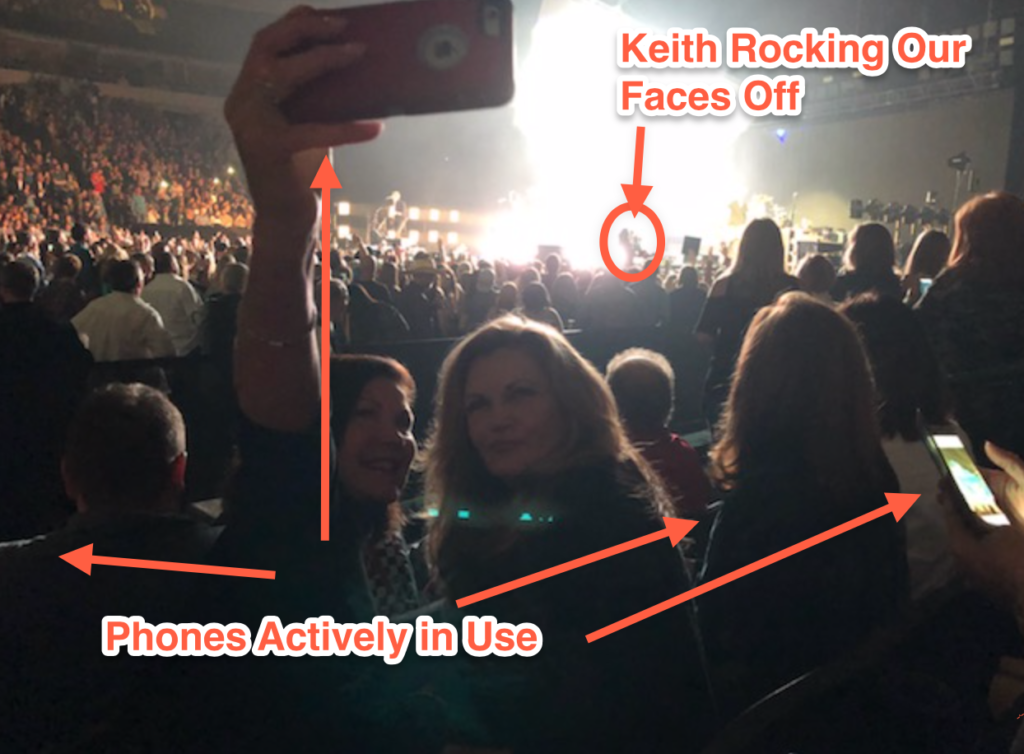I wouldn’t call myself a Keith Urban fan.
But when I was generously gifted a pair of tickets to his Dallas Arena show, I knew Susan and I should check it out.
(Before I get into the meat of this thing, one piece of advice: if you ever have a chance to see Keith Urban… GO. It was a fantastic show.)
We head into the arena and find our seats, which happened to be third row from the floor. We were close. I could have thrown a lime skittle in his mouth.
The second thing I noticed, after the skittle proximity, was the demographic of the Keith Urban fans in this particular section.
80% of the Keith Urbanites around us were age 55 and up –
As you know, this is your primary demographic for your high-ticket elective procedures – premium cataract and refractive lens exchange patients.
“This will be solid people watching,” I thought to myself. I was not disappointed.
Here’s a tip: when you’re out and about, observe other people’s behavior on their mobile devices.
Watch what they’re doing on their phones, what apps they’re using, what pictures they are taking.
Is it creepy? Eh, only if you get caught. So don’t be that guy. But do go to some effort to try to understand and observe how people around you are behaving on their phones.
You can look at statistics all day long, but it really hits home when you see people “out in the wild” actually using their devices.
So I’m sitting there, in this crowd of mostly seniors and baby boomers. The perfect opportunity for market research.
Of the dozen people immediately beside and in front of us, the majority of them had their phones out most of the time.
Several of them were posting comments, check-in’s, and photos on their Facebook pages. Additionally they were going back to Facebook to check comments and notifications and reply to those throughout the concert, while also texting their friends photos they were taking and messages about how fun it was.
(“What the heck, how can you read what they’re saying, Troy?” Because the text size on their phones looks like the headline on your local newspaper. Definitely time for a reading vision procedure. Jumbo Font is not a good look.)
There’s more:
The lady in front of us literally had a selfie stick she was using to photograph herself and her friends.
Speaking of selfies, check out the image below that I took of not Keith Urban.
Sure he’s in the photo, but I took this pic so you could see the ladies taking selfies in the middle of the concert like a bunch of sorority girls.

Why am I telling you all this? Who cares what the grandmothers at Keith Urban are doing?
Too often we think about our senior patients as old people. The problem with that is… they don’t.
Your senior patients not only want to look young and feel young, they believe themselves to still be young. This is their worldview.
They are trying to bring their physical reality in line with who they believe themselves to be.
Have you noticed how you don’t hear the names ‘Grandma’ and ‘Grandpa’ used much anymore?
I definitely had a Granma and Grandad growing up, maybe you did too. But my kids have no Grandmother, no Granpa. At least not by those names. They have a Pop and a Cici and a DocDoc and a G-Pa and a Mizzy.
Neither my mom or my mother-in-law ever said “Ooooh, I want to be Granma!” Why not? Because they aren’t Granmas. Or at least they don’t see themselves as such. They are too young to be that.
Our smartphones and social media addictions are only feeding this feeling.
Your cataract patients are not immune to FOMO (Fear of Missing Out), or the desire to share the most flattering parts of their lives on social media in an effort to gain social points and relevancy.
If you’re using old geriatrics in your advertising… stop. If you think seniors aren’t using social media… They are. If you aren’t using text messaging because seniors don’t text… You hate money.
The people you want to come in your practice and spend $10, $15, $20k on your cash-pay procedures are the same ones buying $500 Keith urban tickets and taking selfies to post on Facebook. Don’t forget that.
That doesn’t mean treat them like teenagers.
But it does mean you better remember who they are and who they want to be – as young as they feel they are. Then help them reach that goal.